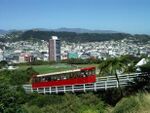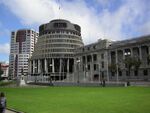Wellington Cable Car
The Wellington Cable Car is a tourist attraction consisting of two cars connected in a funicular standing design, where the weight of one car is used to launch the other car up the hill. The cars are propelled by manual labour with the assistance of a motor the size of a microwave oven. An old microwave oven at that, the sort with dials, and comes with a cook book showing all the wonderful things that can be cooked, such as small animals, by harnessing the gentle power of radiation.
The Cable Car is not a tram.
History[edit]
Wellington, New Zealand is the capital city of the country and its main claim to fame is the resemblances it has to San Francisco. It has lots of steep hills covered with houses and regular earthquakes. The city considered the addition of structures to improve the resemblance. The construction of a large orange bridge proved to be too expensive, and the country did not have enough criminals to justify construction of a maximum security prison in the middle of the bay. A cable car seemed to be the best option due to the economic feasibility at the time.
The next stage of the construction was to determine the best location to place the new attraction. The Lambton Quay was chosen to be one of the locations due to the large amount of traffic caused by the nearby McDonalds. The Cable Car would then be able to take advantage of the large numbers of American tourists who visited the area.
The upper terminal was located at Kelburne, as this allowed tourists and Happy Meal toting small children to go up and visit the Botanical Gardens. The original Cable Car was opened in 1902 and consisted of two trams running along two rail tracks. The current Cable Car is not a tram.
The ride[edit]
To make the ride more special for tourists and small children with their Happy Meals, three tunnels were added to the route. These were lovingly constructed by convict labour, with bricks handmade at the Terrace Gaol. One such worker was bricked into the wall, and to this day his ghost can be seen waiting at Clifton station for a ride home and a Happy Meal. In addition, the ride has its own soundtrack and an on-ride photo section where visitors can take home a souvenir of their Cable Car experience. The Kelburn terminal has a gift shop to make even more money off of tourists. Visitors can purchase "I rode the Cable Car" T-shirts and "The Cable Car is not a tram" bumper stickers.
The original carriages were open to the invigorating Wellington breezes. This enabled young and old to kick against the tunnel sides, and alight from the tram before it had come to a stop. This resulted in broken limbs every couple of trips and the occasional death. No one minded this, because in those days people were not soft, pinko namby-pambys, and they enjoyed their fun.
The Gauntlet[edit]
The Cable Car includes a section of track known as a Gauntlet Track. At this point, riders from opposing trams can slap hands with riders on the other side. Some riders have even taken to jumping from one tram to the other. At each end of the gauntlet track is a frog who directs the trams to the correct track. Sometimes the frogs can get spooked and the Cable Car has to be closed down to prevent collisions from occurring. Should a frog get run over, go missing, or get stolen by an American tourist, a Cable Car employee has to climb up the hill to the nearby Botanical Gardens to find another one.
Animal rights activists oppose this system of using frogs to control the gauntlet track. They cite the fact that the frogs do not receive compensation for the dangerous work.
Accident[edit]
The increasing numbers of American tourists caused problems for the cable car, as it was unable to withstand the increased weight put on the system. In 1973, the brakes on one of the trams failed, and the tram slid down the hill, running over a Ministry of Works worker. As a result, the weight of the trams was reduced by removing the trailers and American tourists were no longer allowed to ride the system. This resulted in fewer fares, and the future of the system seemed to be uncertain.
Of course, the Cable Car is not a tram.
The Present System[edit]
In 1978, construction began on a new Cable Car, more powerful than the first. Now fully enclosed, it is impervious to water balloons, flour bombs, fruit, American tourists, and most other conventional student weapons. Naturally, admission prices were raised.
Now, the majority of passengers on the Cable Car are dirty students and loud-mouthed American tourists with video cameras who, by the time they get to the Tanny Gardens realise that the cable car is really not that great and that the Wellington tourist board is obviously really struggling if they think that tourists will like it. In fact, the cable car isn't even a cable car. Politicians are currently amidst discussions of making the ride more thrilling to visitors. One proposed system concerns the transformation of the current system into a high speed roller coaster with several inversions, including four loops, a cobra roll, and a pretzel loop. Another proposal includes the addition of more routes and extending the existing track.
The Cable Car is definitely not a tram.


